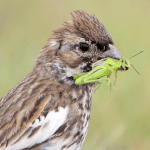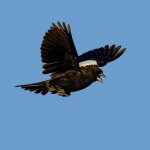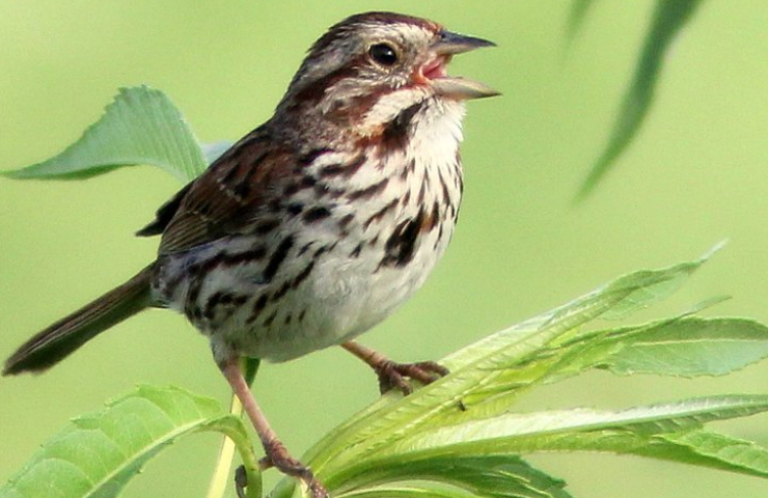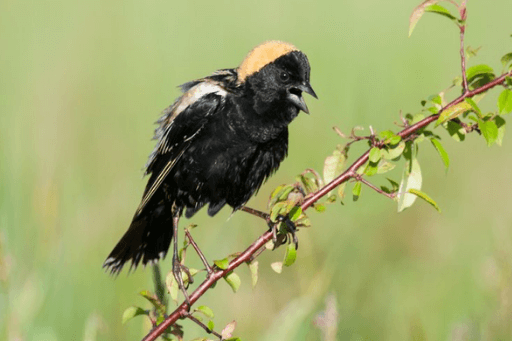About
The male Lark Bunting completely changes in appearance for the breeding season, molting from streaky brown-and-gray plumage (resembling a female or juvenile) to jet-black with bold white wing patches. Over the years, this flashy combination inspired other names such as white-winged blackbird and white-winged bunting.
This is a gregarious species, found in large flocks that sometimes number in the thousands during migration and in winter. Lark Buntings even nest together in loose colonies on dry western grasslands, where they breed alongside species such as the Horned Lark and Mountain Plover.
Sooty Sparrow
Despite its name, the Lark Bunting is actually a member of the sparrow family, more closely related to the Song Sparrow than to the Indigo Bunting. It's probably called “lark” for the male's beautiful song and high-flying displays, and “bunting” after its stubby, conical bill, which resembles that of only distantly related seed-eating relatives. (The word “bunting” is applied to common names of birds in at least three different families!)
Songs and Sounds
The male Lark Bunting's musical song, a series of whistles and trills, is given while perched and during the bird's elaborate flight display.
Listen here:
Breeding and Feeding
Fancy Flight Displays
Like the Sprague's Pipit, male Lark Buntings use flight displays to establish and maintain territory. A male begins his display by rising 20 to 30 feet above the grassland on stiff wingbeats, then he floats back to ground on outstretched wings, singing all the while. Males perform two different flight songs — one given from a perch or while in flight, and a second always given in flight, most often with other males performing the same song. As many as five or six males may display in concert.
Although chiefly monogamous, Lark Buntings may resort to polygyny (one male with several mates) in high-density areas. The female builds a cup-shaped nest in a depression scraped under a shrub. Nests are oriented to take advantage of morning sun, cooling winds, and protection from mid- to late-day sun.
After fledging, immature Lark Buntings form flocks on the breeding grounds, even lingering for a while after adults migrate south.
Grasshopper Gleaner
During breeding season, Lark Buntings feed mainly on insects, particularly grasshoppers, flushing prey from the grass as they run or hop. They also make short flights to hawk insects from the air.
During migration and in winter, Lark Buntings gather in large flocks to forage on seeds, grain, and even cactus fruits.

Region and Range

Lark Buntings breed from south-central Canada to northern New Mexico and Texas; they winter from the southern Great Plains to the Chihuahuan grasslands of central Mexico. In their breeding range, they are somewhat nomadic, tending to concentrate in areas that have received rain and to avoid areas of drought. Because of this, their numbers may fluctuate greatly from year to year at any one location.
Conservation
Although the Lark Bunting is still a common across most of its range, it is classified as a "Common Bird in Steep Decline" by Partners in Flight, with an 86-percent population loss noted from 1970 to 2014. In general, grassland birds in North America, including the Northern Bobwhite and Bobolink, experienced large population declines in the past 40 years.
Pesticides are thought to have played a role in the Lark Bunting's decline, depriving these birds of a key food source, particularly on their breeding grounds. Especially in drought years, Lark Buntings are at risk when drawn to livestock water tanks, where they might slip into deep water and drown, or be preyed upon by free-ranging cats. The species is also vulnerable to collisions with cars.
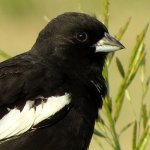
Help support ABC's conservation mission!
ABC is advocating for measures to be included in the latest Farm Bill that have the best chance of helping U.S. grassland bird species rebound. The recommendations included in ABC's “Bird Saver" platform would help the Farm Bill channel funds designated for conservation to the programs that would make the biggest difference for grasslands.
ABC also works with partners across the Americas, such as the Rio Grande Joint Venture and Pronatura Noreste, to preserve and restore the habitats that the Lark Bunting and other declining grassland species — such as the Long-billed Curlew and Baird's Sparrow — require as wintering habitat.
Get Involved
Policies enacted by the U.S. Congress and federal agencies, such as the U.S. Fish and Wildlife Service, have a huge impact on migratory birds. You can help shape these rules for the better by urging lawmakers to prioritize birds, bird habitat, and bird-friendly measures. To get started, visit ABC's Action Center.
Living a bird-friendly life can have an immediate impact on migratory birds in the United States. Doing so can be as easy as adding native plants to your garden, avoiding pesticides, and keeping cats indoors. To learn more, visit our Bird-Friendly Life page.
American Bird Conservancy and our Migratory Bird Joint Venture partners have improved conservation management on more than 8.5 million acres of U.S. bird habitat — an area larger than the state of Maryland — over the last ten years. That's not all: With the help of international partners, we've established a network of more than 100 areas of priority bird habitat across the Americas, helping to ensure that birds' needs are met during all stages of their lifecycles. These are monumental undertakings, requiring the support of many, and you can help by making a gift today.







































